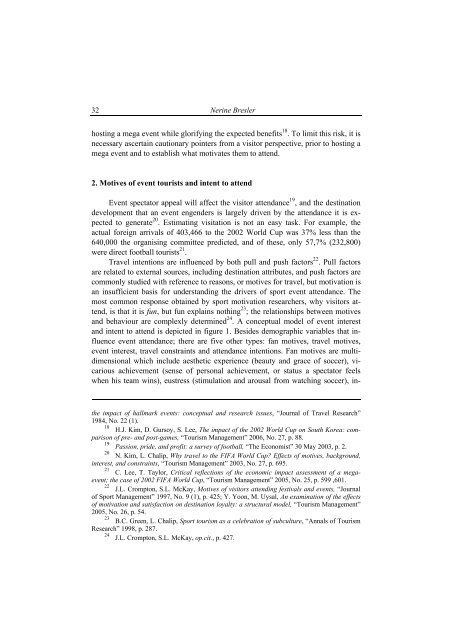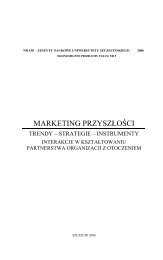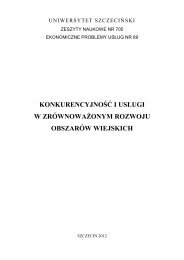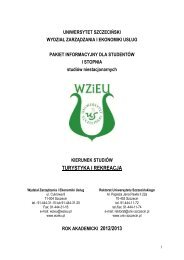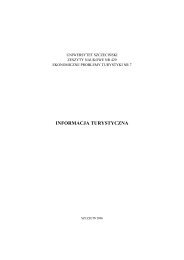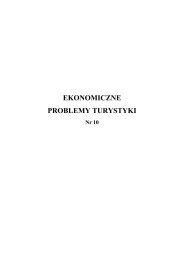Zeszyt naukowy - caÅoÅÄ - WydziaÅ ZarzÄ dzania i Ekonomiki UsÅug
Zeszyt naukowy - caÅoÅÄ - WydziaÅ ZarzÄ dzania i Ekonomiki UsÅug
Zeszyt naukowy - caÅoÅÄ - WydziaÅ ZarzÄ dzania i Ekonomiki UsÅug
Create successful ePaper yourself
Turn your PDF publications into a flip-book with our unique Google optimized e-Paper software.
32<br />
Nerine Bresler<br />
hosting a mega event while glorifying the expected benefits 18 . To limit this risk, it is<br />
necessary ascertain cautionary pointers from a visitor perspective, prior to hosting a<br />
mega event and to establish what motivates them to attend.<br />
2. Motives of event tourists and intent to attend<br />
Event spectator appeal will affect the visitor attendance 19 , and the destination<br />
development that an event engenders is largely driven by the attendance it is expected<br />
to generate 20 . Estimating visitation is not an easy task. For example, the<br />
actual foreign arrivals of 403,466 to the 2002 World Cup was 37% less than the<br />
640,000 the organising committee predicted, and of these, only 57,7% (232,800)<br />
were direct football tourists 21 .<br />
Travel intentions are influenced by both pull and push factors 22 . Pull factors<br />
are related to external sources, including destination attributes, and push factors are<br />
commonly studied with reference to reasons, or motives for travel, but motivation is<br />
an insufficient basis for understanding the drivers of sport event attendance. The<br />
most common response obtained by sport motivation researchers, why visitors attend,<br />
is that it is fun, but fun explains nothing 23 ; the relationships between motives<br />
and behaviour are complexly determined 24 . A conceptual model of event interest<br />
and intent to attend is depicted in figure 1. Besides demographic variables that influence<br />
event attendance; there are five other types: fan motives, travel motives,<br />
event interest, travel constraints and attendance intentions. Fan motives are multidimensional<br />
which include aesthetic experience (beauty and grace of soccer), vicarious<br />
achievement (sense of personal achievement, or status a spectator feels<br />
when his team wins), eustress (stimulation and arousal from watching soccer), inthe<br />
impact of hallmark events: conceptual and research issues, “Journal of Travel Research”<br />
1984, No. 22 (1).<br />
18<br />
H.J. Kim, D. Gursoy, S. Lee, The impact of the 2002 World Cup on South Korea: comparison<br />
of pre- and post-games, “Tourism Management” 2006, No. 27, p. 88.<br />
19<br />
Passion, pride, and profit: a survey of football, “The Economist” 30 May 2003, p. 2.<br />
20<br />
N. Kim, L. Chalip, Why travel to the FIFA World Cup? Effects of motives, background,<br />
interest, and constraints, “Tourism Management” 2003, No. 27, p. 695.<br />
21<br />
C. Lee, T. Taylor, Critical reflections of the economic impact assessment of a megaevent;<br />
the case of 2002 FIFA World Cup, “Tourism Management” 2005, No. 25, p. 599 ,601.<br />
22<br />
J.L. Crompton, S.L. McKay, Motives of visitors attending festivals and events, “Journal<br />
of Sport Management” 1997, No. 9 (1), p. 425; Y. Yoon, M. Uysal, An examination of the effects<br />
of motivation and satisfaction on destination loyalty: a structural model, “Tourism Management”<br />
2005, No. 26, p. 54.<br />
23<br />
B.C. Green, L. Chalip, Sport tourism as a celebration of subculture, “Annals of Tourism<br />
Research” 1998, p. 287.<br />
24<br />
J.L. Crompton, S.L. McKay, op.cit., p. 427.


